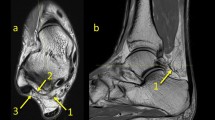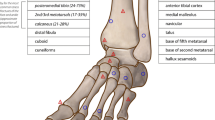Summary
50 patients following talar fractures type Marti 2, 3 and 4 during the years 1972–1993, could be analysed retrospectively. Evaluated factors effecting posttraumatic avascular necrosis of the body of the talus are: type of fracture, age of the patient, additional fracture of the medial malleolus and time of non weight bearing. The Hawkins sign is reliable to show vitality in the body of the talus. We could see vascular impairment in 51 % of all Marti 3 fractures and in 100 % of all Marti 4 fractures. Patients with a concomitant fracture of the inner malleolus showed positive influence on the blood supply of the talus. In this case the ligamentum deltoideum and the ramus deltoideus of the arteria tibialis posterior remained intact. In addition to this the prognosis was better in young patients. A long period of non weight bearing could not preserve vitality of the talus. Necrosis of the talus did only appear in 34 % of the Marti 3 and in 51 % of the Marti 4 fractures. This means that early anatomic reconstruction of the talus is necessary. Primary arthrodesis of the ankle joint and talectomie are not up to date.
Zusammenfassung
In einer retrospektiven Studie konnten 50 Talusfrakturen der Gruppe Marti 2, 3 und 4, die in den Jahren 1972–1993 behandelt wurden, anhand des radiologischen Verlaufs analysiert werden. Entsprechend unserer Auswertung ist das „Hawkins sign“ ein verläßliches Zeichen für die Vitalität des Taluskörpers. Durchblutungsstörungen zeigten sich bei den Marti 3 Frakturen in 51 %, bei den Marti 4 Frakturen in 100 %. Faktoren, die die Durchblutung günstig beeinflussen sind junges Patientenalter und die Begleitverletzung des Innenknöchels, wodurch das Deltaband und der R. deltoideus intakt bleiben. Eine lange Entlastungsdauer konnte lediglich in 1 Fall zur Verbesserung der Durchblutungssituation beitragen. Die Nekrosehäufigkeit liegt in unserem Patientengut bei den Marti 3 Frakturen bei 34 %, bei den Marti 4 Frakturen bei 54 %, sodaß die primär taluserhaltende Operation gefordert werden muß.
Similar content being viewed by others
Author information
Authors and Affiliations
Rights and permissions
About this article
Cite this article
Lutz, M., Golser, K., Sperner, G. et al. Posttraumatic vascular impairment of the talus-is necrosis inevitable. Unfallchirurg 101, 461–467 (1998). https://doi.org/10.1007/s001130050296
Published:
Issue Date:
DOI: https://doi.org/10.1007/s001130050296




